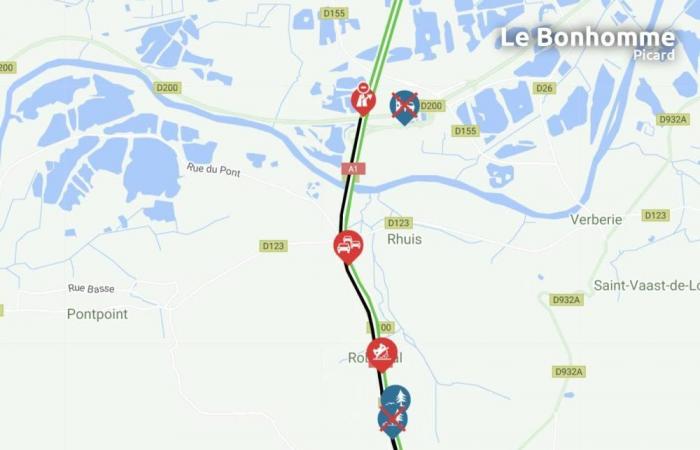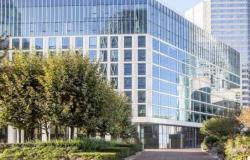This Saturday, November 16 in the morning, Sanef announces that the A1 motorway is closed in the Lille/Paris direction near Pont-Sainte-Maxence following an accident.
An accident involving several vehicles, one of which is on fire, requires the closure of the axis in order to allow emergency services to intervene.
Exit 9 (km 54) Pont-Saint-Maxence is therefore obligatory for those traveling in the Lille/Paris direction. Priority is given to emergency services.
For those who had already passed exit 9 and found themselves stuck behind the accident, an evacuation via a service exit will be organized in the coming minutes.
Other difficulties
On the A16, a vehicle is stopped at Le Touquet, Sanef teams intervene. This requires caution for drivers. The right lane is closed to traffic.
Work on the A1
Until August 30, 2025, SNCF Réseau is providing a new connection between the South of Hauts-de-France, the North-East of Val-d'Oise and the Roissy Aéroport 2 TGV station. In this context, a new railway structure will pass above the A1.
During this work, and for safety reasons for both drivers and intervention personnel, traffic restrictions are necessary between the A1/N104 interchange and diffuser no. 7 Survilliers, with:
- The occasional neutralization of tracks, in line with the work,
- The nighttime closure of the A1, during the installation of the structure above the tracks.
Sanef then deploys appropriate signage and diversion routes to guide you.
Dangerous behavior persists
As risky behavior remains a major road safety issue, the Sanef Observatory is interested in specific subjects: speed, safety distances, lane occupancy, use of turn signals, overruns on emergency lanes.
After a slight decline until 2018, the speed remains at its highest level since the creation of the observatory.
Respecting safety distances
In 2023, 42% of vehicles drive above the authorized speed, compared to 38% in 2018. At night, they are even 51% of drivers who drive above 130 km/h.
Speed remains the main cause in 16% of accidents* and is responsible for1 accident in 6.
In 2023, 22% of vehicles drive too close to the vehicle in front of them (compared to 29% in 2022). On weekends, the phenomenon increases with 26% of vehicles that do not leave the 2 seconds with the vehicle in front.
The results also improve for vehicles that accumulate too fast and too close, with 9% on all routes against 12% in 2022. They remain despite everything 14% on the left lane to combine speed and non-compliance with distances.
Keeping your distance from the vehicle in front is essential, because if an unforeseen event occurs, it is almost impossible to avoid the accident.
Lane occupancy: still poorly adapted
If there is one behavior that has changed little since the creation of the observatory and has caused people to react, it is the poor occupation of the tracks! Even if staying in the middle lane may seem more comfortable to drivers, this attitude is prohibited and above all dangerous.
In 2023, 39% of drivers continue to occupy the middle lane when they could fall back.
This phenomenon is accentuated during the day on weekends with more than 1 in 2 drivers misuse the middle lane.
The impact of theoccupancy of the central lane is underestimatedit induces more delicate overtaking maneuvers and can also cause risky and prohibited behavior, such as overtaking on the right.
The use of indicators still not systematic
In 2023, the figures change little compared to the last two editions of 2019 and 2022, with 28% of drivers who do not report their overtaking.
There are even 39% who do not report their reduction.
Heavy goods vehicles overflowing onto the emergency lane
More and more accidents involve vehicles or pedestrians present on the emergency lane: customers stranded, breakdown repairers and motorway agents on intervention… everyone is concerned.
Also, for the 4th consecutive year, the Sanef group wanted to observe and quantify the intrusions of heavy goods vehicles on the emergency lane.
If the figures are improving in 2023, the observations remain worrying, in fact, 4.3% of heavy goods vehicles traveling on the right lane overflow onto the emergency lane, i.e. one intrusion every 3 minutes on average.
The turn signal is an essential safety elementbecause it is the only way to communicate with other drivers and allows you to signal any change of lane.
Accident: apply the safety corridor to protect their lives
Registered in the Highway Code since 2018, the safety corridor provides the obligation for all drivers to slow down and move aside (change lanes if possible) when approaching a vehicle stopped on the emergency lane.
Accidents among motorway workers are not inevitable: by respecting the safety corridor, many accidents could be avoided.
This is why the Sanef group is launching an awareness campaign, at the time of All Saints' Day vacation departures, in order to make the corridor known and apply






